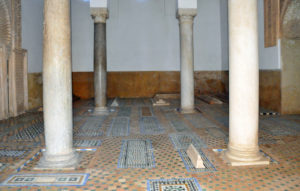
Saadian Mausoleum in Marrakech, Morocco (Photo by Don Knebel)
In 1554, the Saadi family became rulers of all of Morocco. In 1578, Moroccan forces defeated a crusade, led by 24-year-old King Sebastian of Portugal. Using the wealth from the ransom of European prisoners, Ahmad al-Mansur, the sixth Saadi sultan, constructed El Badi (“the marvelous”) Palace in his capital of Marrakech, modeled on the Alhambra. When finished, the palace contained 360 rooms, a massive courtyard and a pool measuring 300 feet by 60 feet. Palace rooms were decorated with marble from Italy, gold from Sudan and jade from China. Al-Mansur and later Sultans used the palace to host lavish receptions for European ambassadors, showcasing Moroccan power.
Before al-Mansur died from the plague in 1603, he constructed tombs in the grand style of El Badi Palace for the royal family, their servants, and government officials. The tombs included two mausoleums, one with twelve columns, which eventually sheltered a total of 66 graves, and a garden containing more than 100 graves. In 1672, Moulay Ismail ibn Sharif claimed the title of Sultan of Morocco and displaced the Saadi dynasty. Over a ten-year period, he demolished El Badi Palace. Apparently afraid to destroy the resting places of the dead, he sealed and hid the Saadian tombs. The French rediscovered the tombs in 1917, restored them to their original grandeur and opened them to the public.
A visit to the Saadian tombs, a major Marrakech attraction near the Kasbah Mosque, conveys the style and elegance of El Badi Palace. A few of the grave markers, both in one mausoleum and in the garden, are oriented in an east-west direction, perpendicular to the remainder. They mark the graves of Jewish members of the royal staff.
Comments are closed.